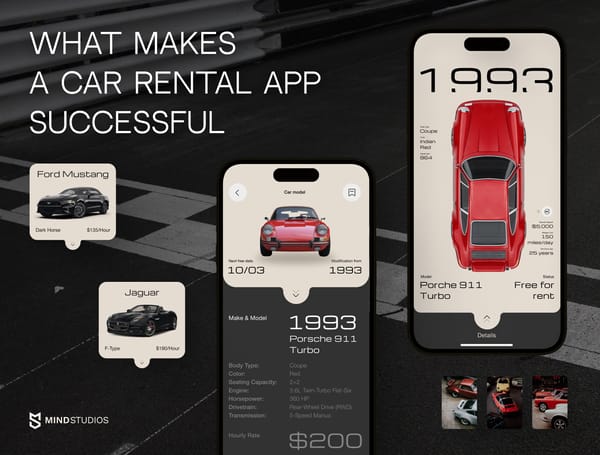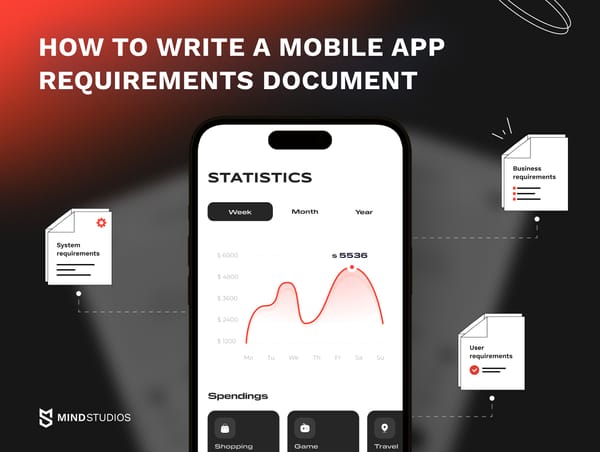When you get the best idea for an app, hundreds of questions immediately appear. It’s normal, especially the first time, but it tends to throw you for a loop.
Based on our nine years of experience in mobile app development, we've prepared answers to the most frequently asked questions about what to do with an app idea and how to take an app idea to market. Take a look at this step-by-step guide to put your thoughts in order and turn your idea into a successful app.
Contents:
- Research the market
- Create a business plan
- Choose app developers
- Raise funds
- Build an MVP
- Keep on improving your app
- Expand your app’s presence
- Extra questions
I have an idea for an app. How should I start?
Step 1. Research the market
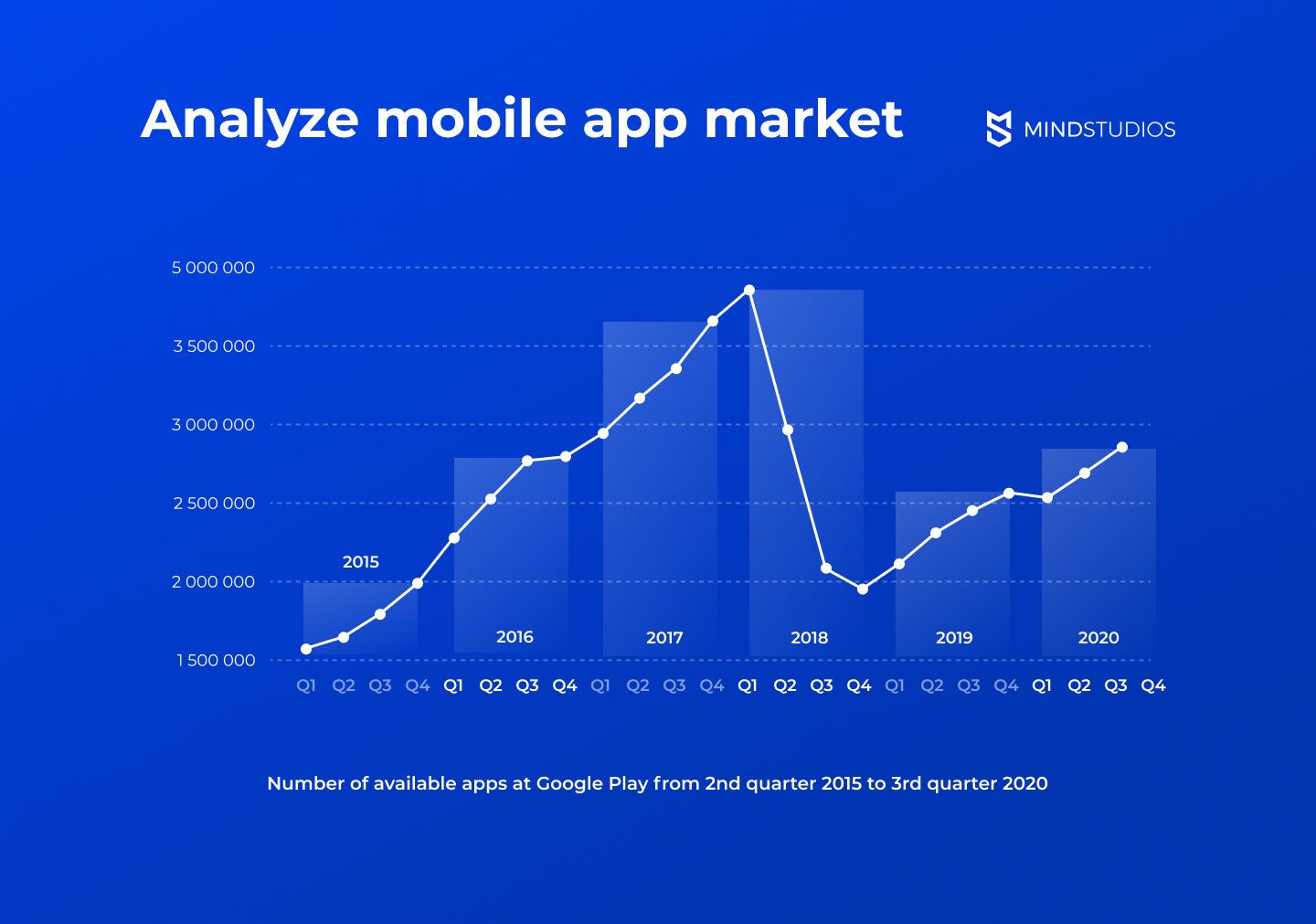
With 1.96 million apps in the Apple App Store and 2.87 million apps in the Google Play Store, there’s a lot of competition. You need to compare your app’s utility with that of apps provided by your competitors.
Analyze your competitors. Choose up to five leaders in your app’s category and analyze the following:
- SWOT (strengths, weaknesses, opportunities, and threats)
- Crucial app features (unique value proposition, call to action)
- Attractiveness of the UI/UX design (original graphical elements, top-notch technologies)
- Drawbacks (flaws, bugs)
- User acquisition channels (target audience, traffic sources, marketing campaigns)
- Revenue (free options, paid features, monetization model)
- Ratings (user reviews, rankings, app store ratings)
The main reason mobile apps rise to the top is that they effectively resolve pressing issues of target users. Your app’s ability to manage a particular problem better than other apps is the key to your success.
That’s why you should thoroughly analyze your target audience, classifying them by the following characteristics:
- Demographic, geographic, and social criteria (gender, age, education, family status, income, profession, geographic location)
- Interests (favorite movies, entertainment, and literature, hobbies, political views, sports activities)
- Needs (product quality, wide range of goods, acceptable cost/quality ratio)
- Motivations (entertainment, improving health, self-expression, education)
Ways of making decisions (based on friends’ recommendations, based on discounts/bonuses) - Reasons to use your app (price, discount, attractive design, positive reviews, useful features, recommendations)
- Solvency (average check size, purchase frequency, app features users would like to pay for)
In brief, you need to become your user. Get a feel for the problems your users face, find out how users would like to solve them, and look at your app through the users’ eyes.
I have an app idea and have done market research. What do I do next?
Step 2. Validate your idea
Validation is an action taken to prove that something is, well, valid: worthy of something, be that time, money, or effort.
Sure, you know that your app idea is valid — after all, you’ve come up with it, so it has meaning for you and maybe for a number of your friends and family members. It’s a great idea, isn’t it? Why would you need to validate the application idea further? More specifically, why would you need to validate the idea and not the app itself?
The answer is quite simple.
While you can skip app idea validation, going through with it adds some level of insurance so that your investment doesn’t go to waste.
In software development, app validation is one of the most crucial parts of each project because there’s more to it than what the dictionary says: validation ensures that the idea has the potential for bringing profit.
Stages and strategies to validate your app idea
Validation of the idea for your platform is one of the first steps you’ll take with your team of app developers. This process helps you answer questions that are vital when you need to make decisions throughout the mobile app development process.
The idea validation process starts with answering a set of questions to create a kind of business plan for the project.
Who are your potential customers?

You aren’t just dumping thousands of dollars to make an app for yourself, are you? You’ll need people to download your app and interact with it. And targeting the wrong users is one of the main reasons startups, especially mobile ones, fail.
You need to find your audience, divide it into segments, and analyze each segment. The more details you can come up with for your typical user, the easier it will be to create an app that will meet the needs of your audience and find the right marketing strategy to make money. Your early adopters will become your primary source of information on what you’re doing right and wrong.
What problem does your app solve for your customers?
At the heart of every popular app is a problem that users want to solve. Messengers help us keep in touch with family and friends, streaming apps and mobile games offer entertainment on the go; we even manage our finances and plan our days with apps. If your app doesn’t solve a problem, no one will want it.
Now, you probably had a problem in mind when you came up with your app idea; these things don’t just come out of nowhere. There was a pain that you or someone you know had and you decided to find a way to relieve it. That’s great. Now you need to check whether other people feel the same pain.
One of the best ways to evaluate your app idea is market validation — ask your audience for some feedback. Nowadays, you have at your disposal a number of options besides face-to-face interviews to ask people all over the world what they think. Facebook, Twitter, Quora, Reddit, Google surveys — you can collect more data than you could imagine without leaving your desk.
What’s your solution to the problem?
Working out your solution is not an easy task. To catch the eye of customers and lure them to your offer, your solution needs to be better than those of your competitors.
During the app validation process, conduct market research for apps, find your biggest competitors, and analyze their offers. Create a matrix of features you plan to add to your app and compare it to the matrices of competitors’ apps.
Create a value proposition that will turn users to you. Your app should offer something unique or should perform better or be cheaper: there should be something that will benefit your customers. If you have nothing to set you apart from the crowd, why would people choose you? They won’t.
After researching the competition, turn back to feedback from potential users. Ask them whether they’re ready to pay for the solution you’ve come up with. If your idea is marketable, you can proceed.
Not everything will go smoothly, of course. However, don’t disregard negative feedback It can teach you heaps about what to do to make your app better than any existing solutions.
What are your app’s strengths and weaknesses?

SWOT analysis — analyzing your strengths, weaknesses, opportunities, and threats — is essential for app idea validation.
When you start thinking about how to find and validate app ideas, you need to know your own business to a T. Without understanding your weaknesses, it will be hard to evaluate and eliminate possible threats, while knowing your strengths will help you find the perfect niche to expand into.
How are you planning to get revenue?
The cost of mobile app development is high, and you’ll need investment. Unless you have ample mobile app funding from elsewhere (for example, if your app is only a small part of your business), you’ll need to get revenue from it.
What metrics are you planning to use?
You can measure the performance of your app in many ways. All kinds of metrics exist today. There’s no ultimate key performance indicator you can track to ensure profitability. Except maybe the star ratings in the app stores.
Different sources list different KPIs as the most important, but you’ll have to choose yourself after some research and discussion with a business analyst (your own or an analyst at your mobile app development company). Depending on the type of app you’re developing, your revenue model, and your target audience, the recommended metrics will differ.
Among universally acknowledged metrics are:
- User satisfaction
- Session length
- Average revenue per user
- Hours of use per month
- App opens
- Number of active users
- Retention rate
Step 3. Create a mind map

Once you’ve learned how to evaluate your app idea and you’ve gone through with it, you’ll have a general picture of how to approach the project. This is when it’s time to create a mind map.
Most software development companies practice an agile methodology or the narrower lean methodology. Both of these systems make use of mind mapping since it makes team collaboration easier. Agile is based on collaboration at all stages of development.
Mind mapping is the second to last step of the app idea validation process; it’s a result of sorts.
Mind mapping will help you and your team make sense of all the information available, direct your development, and roughly break down the stages of development into iterations.
With a mind map, you’ll have a history of changes and will always be able to check where every change originated. It also provides an organized visualization of the development process, which can push your brainstorming sessions to a new level and help you come up with better ways to implement features, speed up the development process by cutting less valuable parts, and so on.
The best thing about mind mapping is that it’s flexible and can be adjusted on the go to fit what’s needed and remove what’s excess. After all, when the actual coding and design begins, changes will come running seemingly out of nowhere.
Step 4. Come up with a business plan
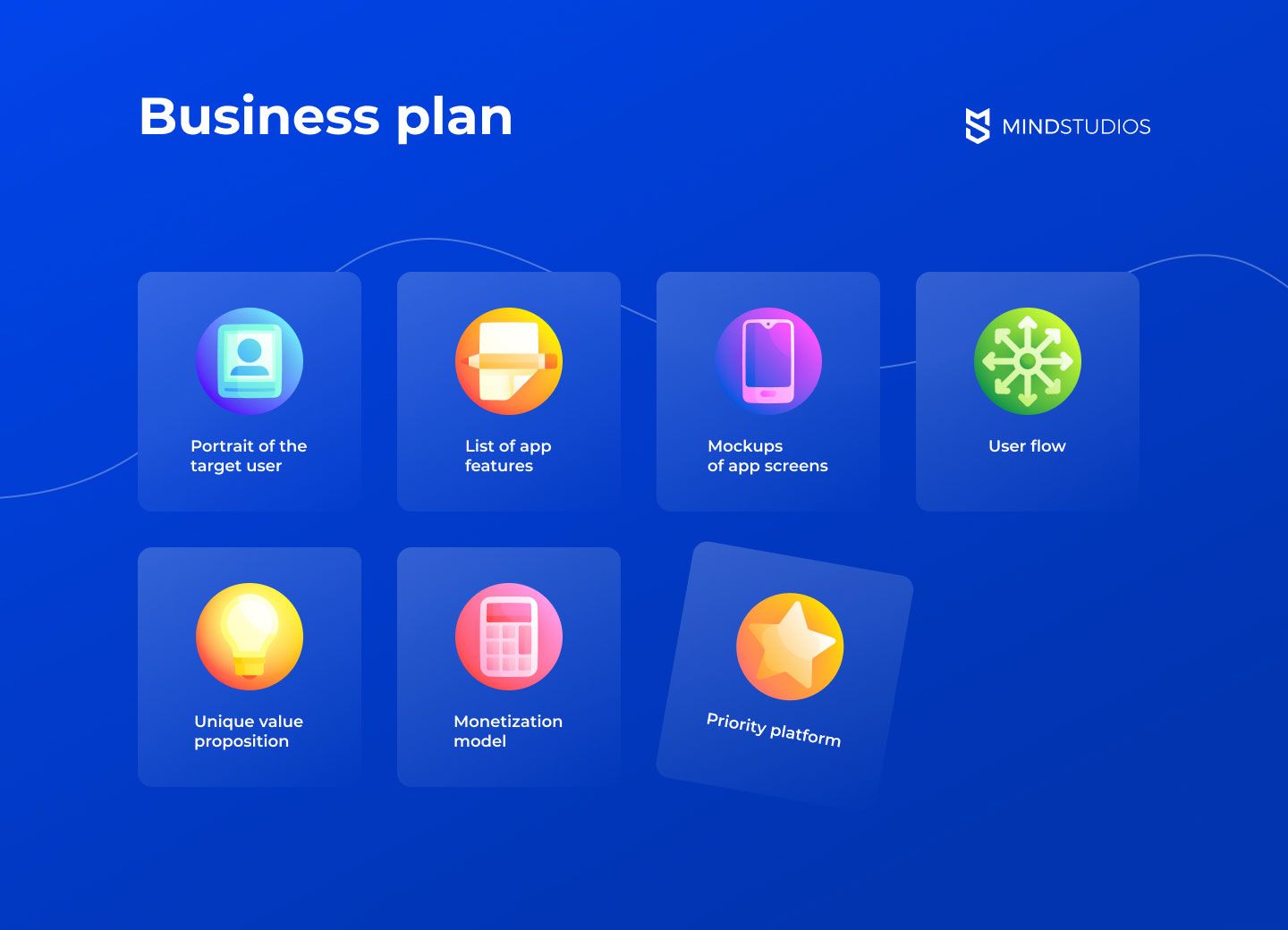
Market research gives you plenty of valuable information, but unfortunately, it does this without clarifying how to develop your app. So as not to feel you’ve bitten off more than you can chew, you should slice and dice your business concept on paper by writing a business plan for mobile app idea.
In your business plan, you should do the following:
-
Describe your proto persona. Compose a portrait of your target user based on the characteristics mentioned above. Define your target active user and paying user.
-
Sketch your app features. Make a list of all app features and divide them into crucial features, features you need to develop first, and extra features you can add afterward. Make mockups of app screens and trace the user flow.
-
Determine your unique value proposition (UVP). Think of the main competitive value your app offers. Find your killer feature — the strongest feature that will entice users to perform in-app actions. Come up with your UVP and enhance it with a powerful call to action (CTA).
-
Choose a monetization model. More often than not, the best time to find an appropriate way of making money from your app idea is at the get-go. There are five common models to monetize an app. You can combine them or adopt them separately:
| Monetization model | Advantages |
|---|---|
Advertising (using ad banners) |
|
Freemium (combination of free and paid features) |
|
Premium (subscription provides access to specific content) |
|
In-app purchases (in-app sales of physical products, virtual goods, or services) |
|
Paid apps (must pay before downloading the app) |
|
- Choose a priority platform. To reach more people, it’s best to launch an app on both Android and iOS, but you should consider that developing an app for two platforms doubles the cost. If you have a limited budget, find out which platform is more popular among your intended users and prioritize it.
How to develop an app idea if I don’t know how to code?
Step 5. Choose app developers

If you have an idea for an app but no programming skills, after business planning, you should think about who can execute your app idea. Whom to hire and what number of specialists you need depends on many factors:
-
How many platforms will you publish your app on?
-
Will you hire extra specialists for your in-house team or assemble a development team from scratch?
-
How much time and money are you ready to allocate to app development?
-
What is the complexity and scale of your app?
Building a full-fledged mobile app involves many development stages: you need to write code, manage data, create a design, test the app’s functionality, and control team performance. To do this you’ll need a team that consists of these specialists:
- iOS developer
- Android developer
- Backend developer
- UI/UX designer
- QA specialist
- Project manager
The next stage is to decide whom to entrust with developing your app. You can rely on:
-
In-house team. If you already have an in-house team of mobile app developers, you need to be sure of their skills. What if they can’t develop a cutting-edge app? You should be prepared for the necessity of hiring additional developers when budgeting for your app development.
-
Freelancers. When you need to hire missing specialists for your app development team, hiring freelancers is an accepted approach. But it can lead to communication issues, require additional time for management from your side, and increase the risk of revealing confidential information.
-
Outsourcing development company. If top-notch technologies, fast app development, and keeping within your budget are your primary concerns, you should choose an outsourcing app development company. Working with an outsourcing company also enables you to free up time for your core business competencies.
I have an idea for an app but no money. What should I do?
Step 6. Raise funds
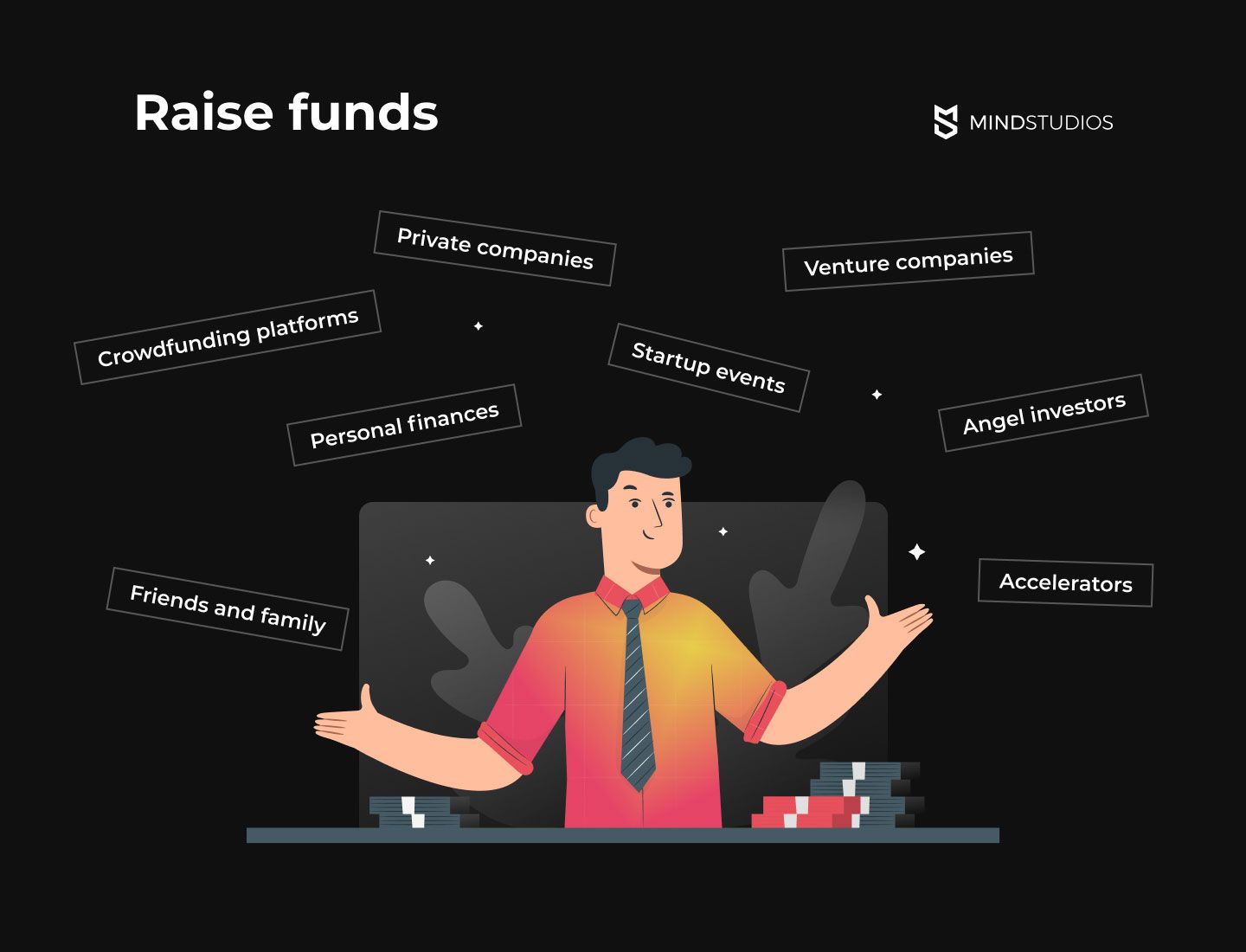
Lack of money for starting a business isn’t a new story. If you have an idea for an app but no money to start your business, it’s not doomsday. You can raise investments provided you have a positive mindset.
Let’s take a closer look at sources of funding for your mobile app startup:
Personal finances |
Self-funding allows you to stand on your own two legs, retaining ownership and complete control of your app. The main disadvantage of this approach is that your capital is finite. |
Friends and family |
You can pitch your idea to your family members or friends to find a trustworthy partner or co-founder. But if something goes sideways and you can’t return the money, it will likely be the end of your relationship. |
Services and events for startups |
Visiting a startup conference allows entrepreneurs not only to network but to find potential investors for business ideas. You can use startup services like Startups to validate your app idea and request funds. You can also take part in app funding competitions. |
Crowdfunding platforms |
The principle of crowdfunding websites is simple: you post your app idea and find people who are interested in funding it. Because contributors are individual investors, they might invest little money. Nevertheless, due to the quantity of contributors, you can gather solid funds. Visit Crowdfunding.com to choose the appropriate platform. |
Accelerators |
Accelerators are organizations that provide coaching and assistance for newly hatched startups to build their businesses. An accelerator can show you how to get started and how to expand your small business into a profitable company. In addition to mentorship, you can find sponsors for your app at accelerators like Y Combinator and Techstars. |
Angel investors |
You can register in special business networks and get angel investment from individuals who are interested in funding noteworthy startups. As a rule, angel investors ask for 10% to 25% of the shares in your business. You can get business contact information for angel investors on the Angel Capital Association or European Business Angels Network, or you can look for an angel network in your location. |
Venture companies |
If you succeed in getting venture capital funding, your mobile app will launch as fast as possible and likely grow into a large-scale project. This type of investment comes from venture firms or funds like 500 Startups. Venture companies usually give money in exchange for 25% to 50% of the shares in a mobile app project to ensure a return on their investment as quickly as possible. |
Private companies |
A lot of big app development companies buy small apps because they want to enlarge their footprint in niches where they don’t have popular apps. Approaching private companies like AppShopper can help you to sell an app or even a whole company. |
Bank credit |
Banks often finance ideas for mobile apps that are supported by well-thought-out business plans. As banks are only interested in making a profit, bank loans are the worst option for startups. Banks expect you to return a certain amount of money by a specified date without any favors. |
To get funding, you need to create an attractive pitch for your business idea. There are different types of app pitches that you can use according to your funding stage.
At the pre-seed stage, when your goal is to attract your friends and family to invest in your app idea, it’s enough to have an informative presentation. You can also create an app landing page, which you can use to promote your app when you need to attract users to a working app prototype or request substantial investment to keep on the mobile app development process.
If you want to increase your chances of attracting substantial investment, the best way to do it is to create a demo version of your app. A working app prototype will have the power to persuade people to finance your project. A prototype allows you to demonstrate your app idea in action instead of simply showing sketches on paper.
I have an app idea and have secured funding. What next?
Step 7. Build an MVP
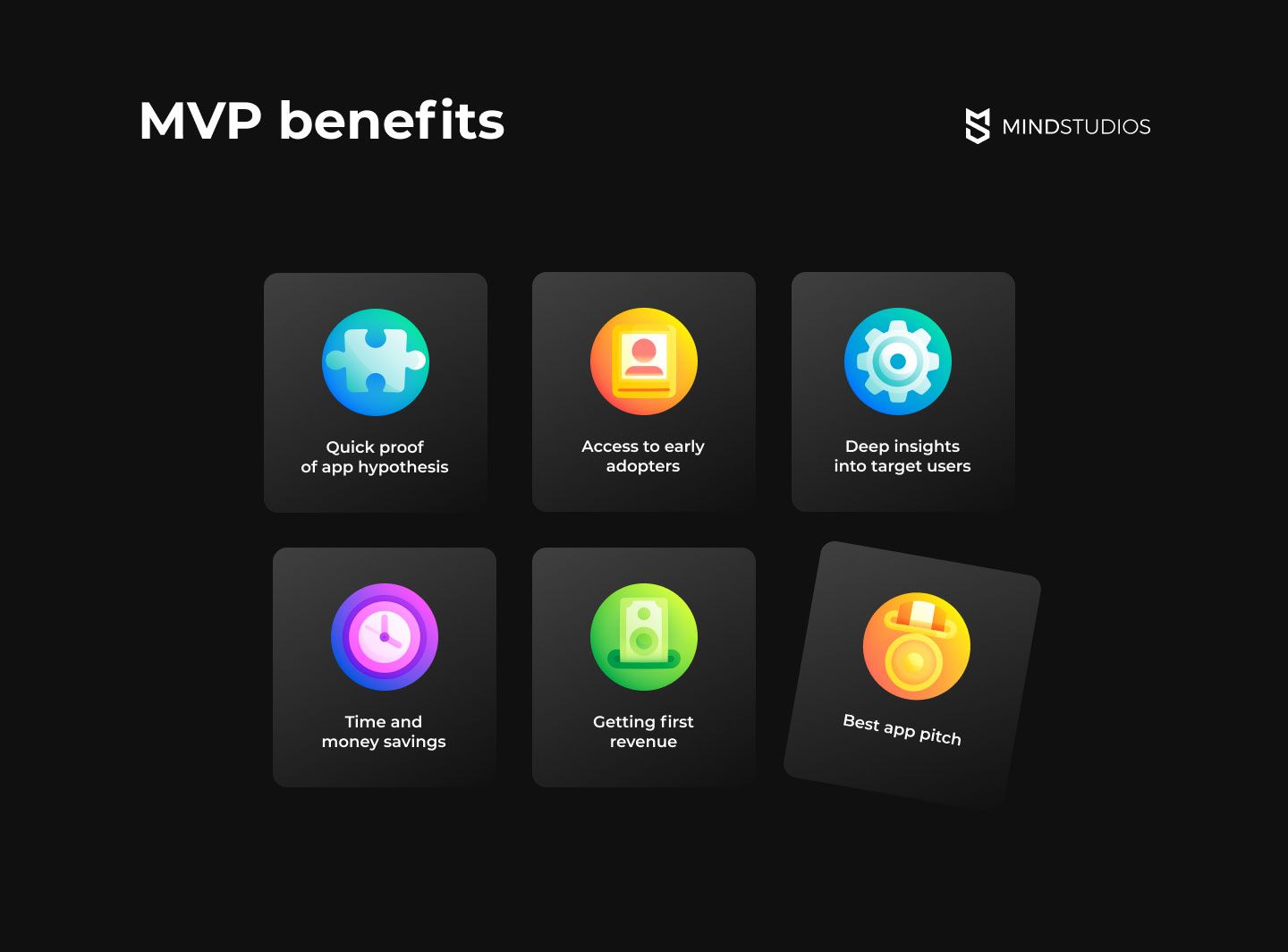
After doing market research, drawing up a business plan, and securing financial support, you need to validate your app’s hypothesis.
There’s no need to build a full mobile app. A faster and cheaper way to assess the viability of your app idea is to build a minimum viable product (MVP). As the name suggests, an MVP includes a minimum set of features that your app can’t function without.
Building an MVP solves many tasks in one go:
-
Checks the viability of your app idea
-
Helps you get early adopters and receive important feedback
-
Gives you a clear look at your target audience
-
Keeps down development time and costs
-
Makes it possible to bring in revenue before launching a full app
-
Serves as a powerful tool to attract bigger investors
What to do with an idea for an app after my MVP is developed?
Step 8. Keep on improving your app
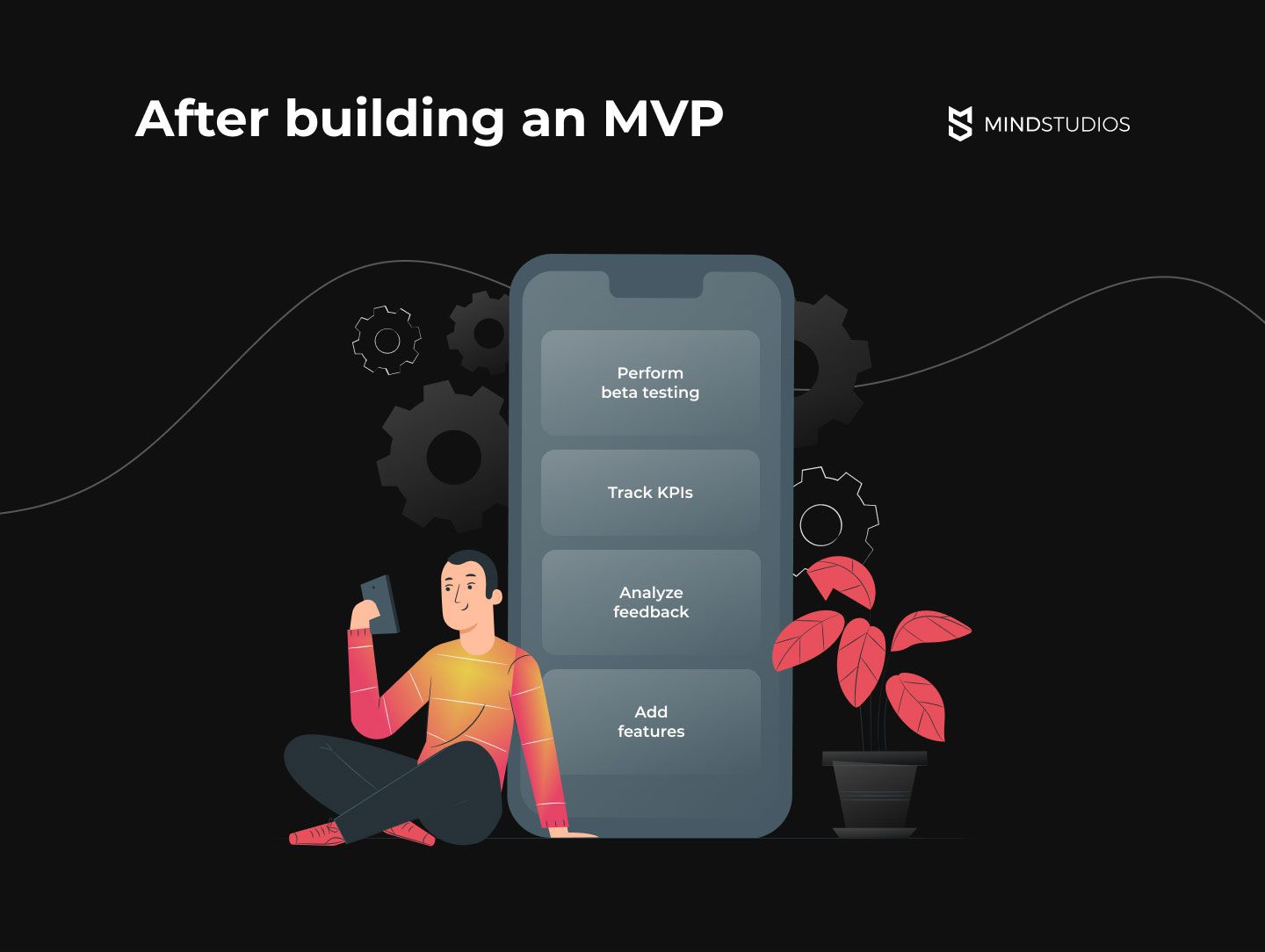
Building an MVP entails testing, getting feedback, fixing bugs, and empowering your app with new features. Then you repeat the cycle: test again, adjust flaws, and release.
Let’s take a closer look at each step you should take after developing your MVP:
-
Perform beta testing. Beta testers are real people who use your app and share their impressions. Due to beta testers’ feedback, you can gauge your app's viability, reveal flaws, and add feature ideas to your backlog.
-
Track your mobile app’s metrics. To control how your app works after launching it on the app store, you need to monitor its performance, user engagement, and app revenue metrics like the conversion rate, retention rate, number of downloads, session duration, and lifetime value. There is a variety of mobile app KPIs. You should choose those that will provide the most useful insights given your app’s category.
-
Analyze feedback. You should monitor user feedback and quickly respond to user reviews, especially negative ones. This helps you figure out what you need to change or improve in your app, helps you transform users’ attitudes to your brand, and gives you deep insights into your target users. Don’t restrict yourself by monitoring the app store’s feedback sections — use YouScan to track your app’s reputation anywhere it’s mentioned.
-
Add features. Now you need to consider what you’ve learned from steps 1,2, and 3 to decide what features you should implement next. Reopen your backlog with feature ideas, define what features are likely to increase your KPIs, and see what features users want you to change. This will help you choose the features you need to add in the particular iteration.
You should iterate the process of improving your app’s functionality until you get a full-fledged, hassle-free mobile app.
How to take an app idea to market?
Step 9. Expand your app’s presence
Besides improving your app’s functionality, you need to focus on how to keep people using your app. You also need to figure out how to get high-paying conversions to consistently boost your revenue along with marketing innovations you can implement to become a brand recognized all over the world.
We’ve prepared a rundown of tasks to expand your app’s presence:
-
Perform maintenance and support. To build a successful business in the long term, you should assist users, respond to their requests, provide technical support, and regularly update your app’s features.
-
Add extraordinary features. Offering users something extraordinary leads them to spend more time in your app, increasing user engagement and attracting more revenue. What cutting-edge features should you use? For example, if you have a custom real estate app, you can implement augmented reality to enable users to visualize properties in the most immersive way.
-
Promote your app. Well-thought-out marketing campaigns can generate ever-increasing traffic and make your app shine brighter than rivals. Here are some of the most effective marketing tools:
SEO/ASO services |
Search engine optimization (SEO) and app store optimization (ASO) serve one goal — to show your app to people searching for something in your niche. To optimize your SEO and ASO, you need to identify relevant keywords. To do this, you can use keyword research tools such as Google Trends, AnswerThePublic, and AlsoAsked. |
Social networks |
According to your previous market research, choose the social networks that are most popular among your target audience and post an attractive app pitch. You can also run paid advertising using Facebook for Business. |
Blog posts / App community |
If you systematically publish information about your service, people will perceive you as an expert in your niche and want to download your app. Also, you can organize an app community using a service like Meetup so users can share their impressions and encourage others to join. |
Press releases |
Announce your app in the media via a press release distribution service like NewsWire or BusinessWire. |
Influencers |
You can collaborate with influencers, who can recommend your app to millions of their followers. |
App contests |
To expand your app’s audience, you can take part in app contests and competitions. Go to BestMobileAppAwards to find some you can enter. |
App directories / App forums |
Post about your app’s benefits on ProductHunt and Reddit forums, and include your new app in app directories like AppAdvice. |
Extra questions if you have an idea for an app
How to protect your app idea?
When you’re focusing on how to bring an app to market, you shouldn’t forget about keeping your app idea safe. Once you’ve told your business model to at least one person, you run the risk that your app idea can be stolen. If it is, you could face myriad copies of your app and lose your users.
Look through some tips on how to protect your business idea during the whole implementation process:
-
Sign an NDA. The parties signing a non-disclosure agreement (NDA) promise to safeguard confidential information. Signing an NDA is an obvious but important part of building trustworthy partnerships in the software industry, whether you hire an individual freelancer or an app development company.
-
Protect your intellectual property. Make sure to insert intellectual property protections in your contract to reserve the rights to your app icon, name, code, graphical elements, and design. If you don’t, third-party specialists, even if you work with relatives or friends, will have every right to reuse everything they’ve made.
-
Get copyright. Copyrighting your app doesn’t restrict other developers from building an app with similar objectives, but it does protect the form in which your app is released. You can safeguard all app frameworks, text, video content, code, color themes, and graphics by getting copyrights.
-
Validate your brand. When your app is going well, it’s time to register your trademark and legitimize your app’s name and logo. Similar to getting a copyright, getting a trademark doesn’t protect your app idea from being stolen, but it can restrict other apps from using your brand visuals.
-
Patent your app idea. The most reliable way to protect your app idea is to get a patent. There’s one but, however: your app idea must be completely innovative (including the code) to obtain a patent. In addition to the difficulty of proving this, there’s no guarantee you’ll be granted a patent, though the process will take a lot of time and money.
I have an app idea. How much does it cost to develop an app?
Developing an app can cost anywhere from $10,000 to $500,000 or even more. The truth is that there’s no straightforward answer because too many factors affect the cost. One of them is the number and complexity of app features.
Building a simple app, such as a minimum viable product with standard or easy-to-build features, can take up to four months and cost from $10,000 to $25,000.
An app with medium complexity (more features, more screens, more complex design) could take from six to ten months to develop and cost from $25,000 to $100,000.
Developing complex apps with advanced features like chatbots, payment services, and augmented or virtual reality will take no less than seven months (or even more than a year). The cost to develop a complex app will likely start at $100,000 and can run up to $500,000 or more.
We’ve prepared a list of our articles on developing different types of apps and our estimates of their development cost:
-
eCommerce mobile app — $31,150
-
Meditation app like Headspace — $54,225
-
Ebook app like Kindle — $52,000
-
Dating app like Tinder — $50,000
-
VoIP app like Discord — $60,000
-
Fitness app — $42,500
If you’re still not sure of the cost to develop an app based on your idea, our managers can provide you with a project estimate — just contact us.
What to do if you have an app idea: Final word
You might feel great excitement when coming up with an idea for an app that can make people’s day-to-day activities more convenient and entertaining. At Mind Studios, we also get excited when we get to take part in creating original, multi-faceted, and useful apps. Let’s combine your mobile app ideas with our capabilities to develop a great software product. If you’re ready, drop us a line.




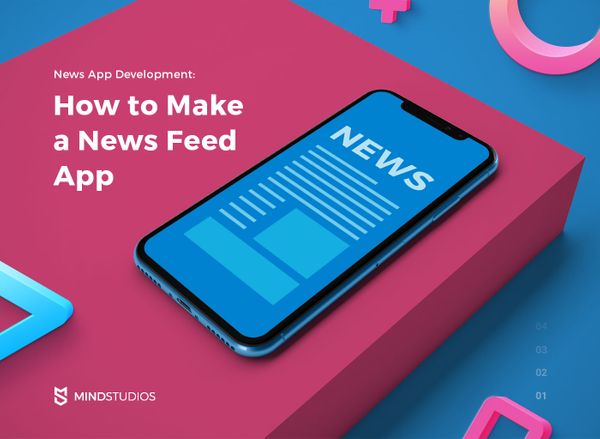
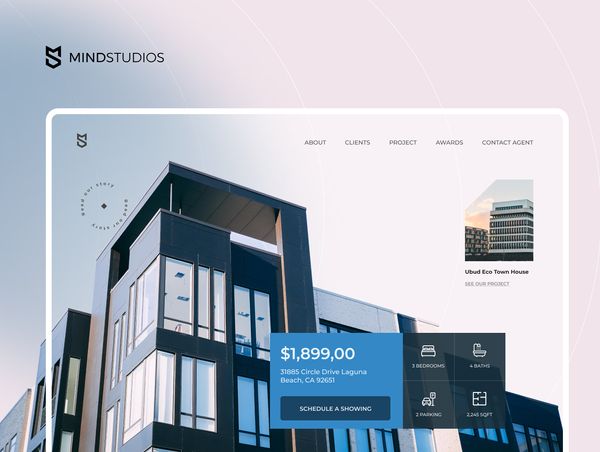
![How to Create an On-Demand Medicine Delivery App [Expert Guide]](https://themindstudios.com/blog/content/images/size/w600/2025/03/IMG-1-Cover-6.jpg)
